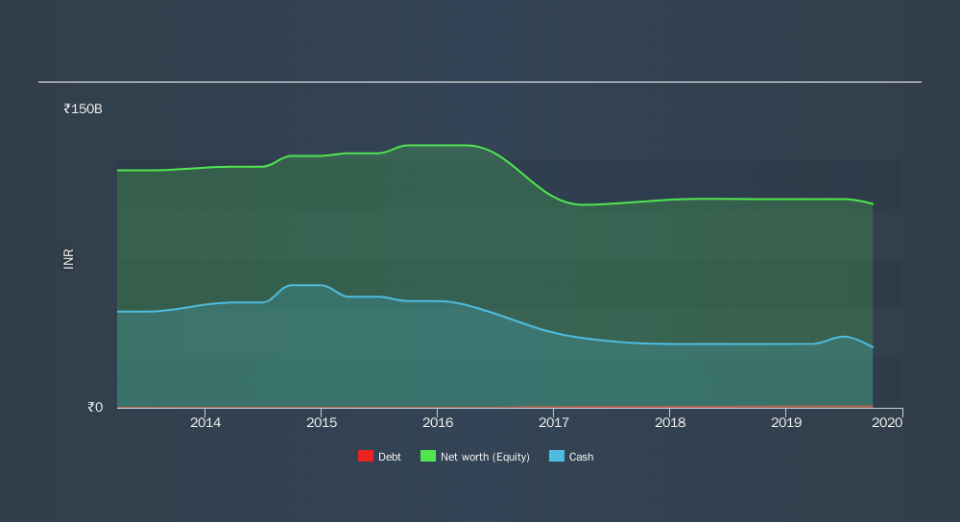Is National Aluminium (NSE:NATIONALUM) A Risky Investment?

Legendary fund manager Li Lu (who Charlie Munger backed) once said, 'The biggest investment risk is not the volatility of prices, but whether you will suffer a permanent loss of capital. It's only natural to consider a company's balance sheet when you examine how risky it is, since debt is often involved when a business collapses. As with many other companies National Aluminium Company Limited (NSE:NATIONALUM) makes use of debt. But should shareholders be worried about its use of debt?
When Is Debt Dangerous?
Debt is a tool to help businesses grow, but if a business is incapable of paying off its lenders, then it exists at their mercy. In the worst case scenario, a company can go bankrupt if it cannot pay its creditors. However, a more common (but still painful) scenario is that it has to raise new equity capital at a low price, thus permanently diluting shareholders. Having said that, the most common situation is where a company manages its debt reasonably well - and to its own advantage. The first thing to do when considering how much debt a business uses is to look at its cash and debt together.
View our latest analysis for National Aluminium
How Much Debt Does National Aluminium Carry?
The image below, which you can click on for greater detail, shows that at September 2019 National Aluminium had debt of ₹747.6m, up from ₹667.9m in one year. But on the other hand it also has ₹30.5b in cash, leading to a ₹29.7b net cash position.
How Healthy Is National Aluminium's Balance Sheet?
According to the last reported balance sheet, National Aluminium had liabilities of ₹29.2b due within 12 months, and liabilities of ₹18.8b due beyond 12 months. Offsetting this, it had ₹30.5b in cash and ₹2.72b in receivables that were due within 12 months. So its liabilities total ₹14.8b more than the combination of its cash and short-term receivables.
Given National Aluminium has a market capitalization of ₹81.2b, it's hard to believe these liabilities pose much threat. However, we do think it is worth keeping an eye on its balance sheet strength, as it may change over time. While it does have liabilities worth noting, National Aluminium also has more cash than debt, so we're pretty confident it can manage its debt safely.
In fact National Aluminium's saving grace is its low debt levels, because its EBIT has tanked 55% in the last twelve months. Falling earnings (if the trend continues) could eventually make even modest debt quite risky. There's no doubt that we learn most about debt from the balance sheet. But ultimately the future profitability of the business will decide if National Aluminium can strengthen its balance sheet over time. So if you're focused on the future you can check out this free report showing analyst profit forecasts.
Finally, a business needs free cash flow to pay off debt; accounting profits just don't cut it. While National Aluminium has net cash on its balance sheet, it's still worth taking a look at its ability to convert earnings before interest and tax (EBIT) to free cash flow, to help us understand how quickly it is building (or eroding) that cash balance. Over the most recent three years, National Aluminium recorded free cash flow worth 55% of its EBIT, which is around normal, given free cash flow excludes interest and tax. This free cash flow puts the company in a good position to pay down debt, when appropriate.
Summing up
While National Aluminium does have more liabilities than liquid assets, it also has net cash of ₹29.7b. So we are not troubled with National Aluminium's debt use. Given National Aluminium has a strong balance sheet is profitable and pays a dividend, it would be good to know how fast its dividends are growing, if at all. You can find out instantly by clicking this link.
At the end of the day, it's often better to focus on companies that are free from net debt. You can access our special list of such companies (all with a track record of profit growth). It's free.
We aim to bring you long-term focused research analysis driven by fundamental data. Note that our analysis may not factor in the latest price-sensitive company announcements or qualitative material.
If you spot an error that warrants correction, please contact the editor at editorial-team@simplywallst.com. This article by Simply Wall St is general in nature. It does not constitute a recommendation to buy or sell any stock, and does not take account of your objectives, or your financial situation. Simply Wall St has no position in the stocks mentioned. Thank you for reading.

